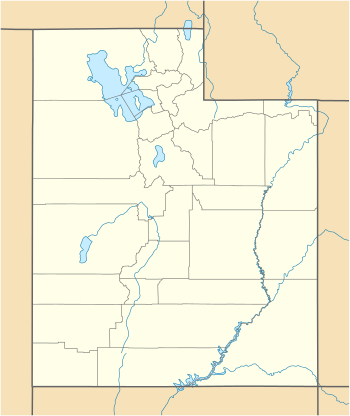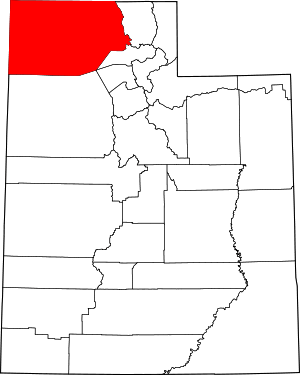Lucin, Utah
Lucin (also known as Umbria Junction) is an abandoned railroad community in Box Elder County, Utah, United States, resettled by a single owner-resident, along the western side of the Great Salt Lake, 162 miles (261 km) northwest of Salt Lake City.
Lucin, Utah | |
|---|---|
 Lucin Location of Lucin in Utah  Lucin Lucin (the United States) | |
| Coordinates: 41°20′54″N 113°54′18″W | |
| Country | United States |
| State | Utah |
| County | Box Elder |
| Founded | Late 19th century |
| Abandoned | 1990s |
| Named for | Lucina subanta |
| Elevation | 4,478 ft (1,365 m) |
| GNIS feature ID | 1437627[1] |
History
Lucin was founded in the late 19th century, about 1 mile (1.6 km) north of its current location, to provide a water stop for railroads to replenish their steam locomotives.
The town was moved in 1903 to serve as a stop for the Lucin Cutoff. Historically, the town’s population consisted mainly of employees of the Central and Southern Pacific Railroads. In 1936 the town was abandoned, and then resettled by a group of retired railroad workers and their children. (I was born in 1947 in Ogden,Utah. but we lived in Lucin. My dad was a section foreman. I remember a lot about Lucin. We left there about 1950, Therefore it was not abandoned in 1936, as stated above.)
For a while, no one had lived in Lucin, until 1997 when Ivo Zdarsky, venturing aviation entrepreneur and manufacturer of the Ivoprop, a plane propeller,[2][3] bought it and moved there.[4]
The area is managed for migrating songbirds and other wildlife by the Utah Division of Wildlife Resources.
The town was named for a local fossil bivalve, the Lucina subanta.[5]
Lucin today
Except for the intermittent (more permanent since 2008[4]) presence of Ivo, town owner and avid solitary explorer, and his IVOPROP Corp research and development activities, Lucin is a ghost town. As of 2016, the most prominent town features are a recent airplane hangar doubling as a residence and a workshop, an adjacent unpaved landing strip, along with several smaller, separate utility buildings (water, fuel, telecommunications, power).[4]
Ivo (as Lucin's only resident prefers to be called), a former engineering student in Prague, made headlines in 1984 as an Eastern Bloc defector, when aged 24 he managed to escape the Iron Curtain by flying then silently gliding over the back-then heavily guarded Czechoslovak-Austrian border. He flew under night cover, avoiding radars, with a custom-built glider powered with a 600cc Trabant engine and propellers of his own design, and landed still undetected at Vienna International Airport.[4] Originally re-settling in California, Ivo eventually sold his DIY plane to the Berlin Checkpoint Charlie Museum's[3] unique collection of escape vehicles. Lucin, on the other hand, offers a practical test-ground, and hosts Ivo's newest flying inventions and other ingenious designs.[4]
A description of what remains from the old town includes a pond fed by a pipe that brings water from the nearby Pilot Range, a group of trees in an otherwise barren desert, and various everyday items left by the former residents. There are no remaining buildings, but there are root cellars and two concrete phone booths.
The original grading of the railroad can be found heading northeast toward Promontory, Utah and the Golden Spike National Historic Site.
The Lucin area is a popular stop for rockhounds looking for an apple- green chert-like phosphate mineral variscite, also known as utahlite and lucinite.[6]
Nearby is a large artwork called the Sun Tunnels, which was created by artist Nancy Holt in 1976.[7]
Climate
According to the Köppen Climate Classification system, Lucin has a semi-arid climate, abbreviated "BSk" on climate maps.[8]
See also
References
- U.S. Geological Survey Geographic Names Information System: Lucin
- Wadler, Joyce (28 March 2012). "In a Remote Part of Utah, Life Alone in a Hangar". The New York Times. LUCIN, Utah. p. D1. Retrieved 31 March 2012.
- Bethea, Jim. "The story behind the IVOPROP". ULTRAFLIGHT Magazine. Retrieved 31 March 2012.
- Great Big Story series (2016-06-06). "The Man Who Escaped the Iron Curtain in a DIY Plane". GreatBigStory.com. published at partner sites CNN.com and MSN.com on 2016-06-07. Retrieved 2016-06-15.
- Utah History to Go
- Bulletin - United States Geological Survey
- Deseret News (Salt Lake City), May 21, 2007
- Climate Summary for Lucin, Utah
External links
| Wikimedia Commons has media related to Lucin, Utah. |
